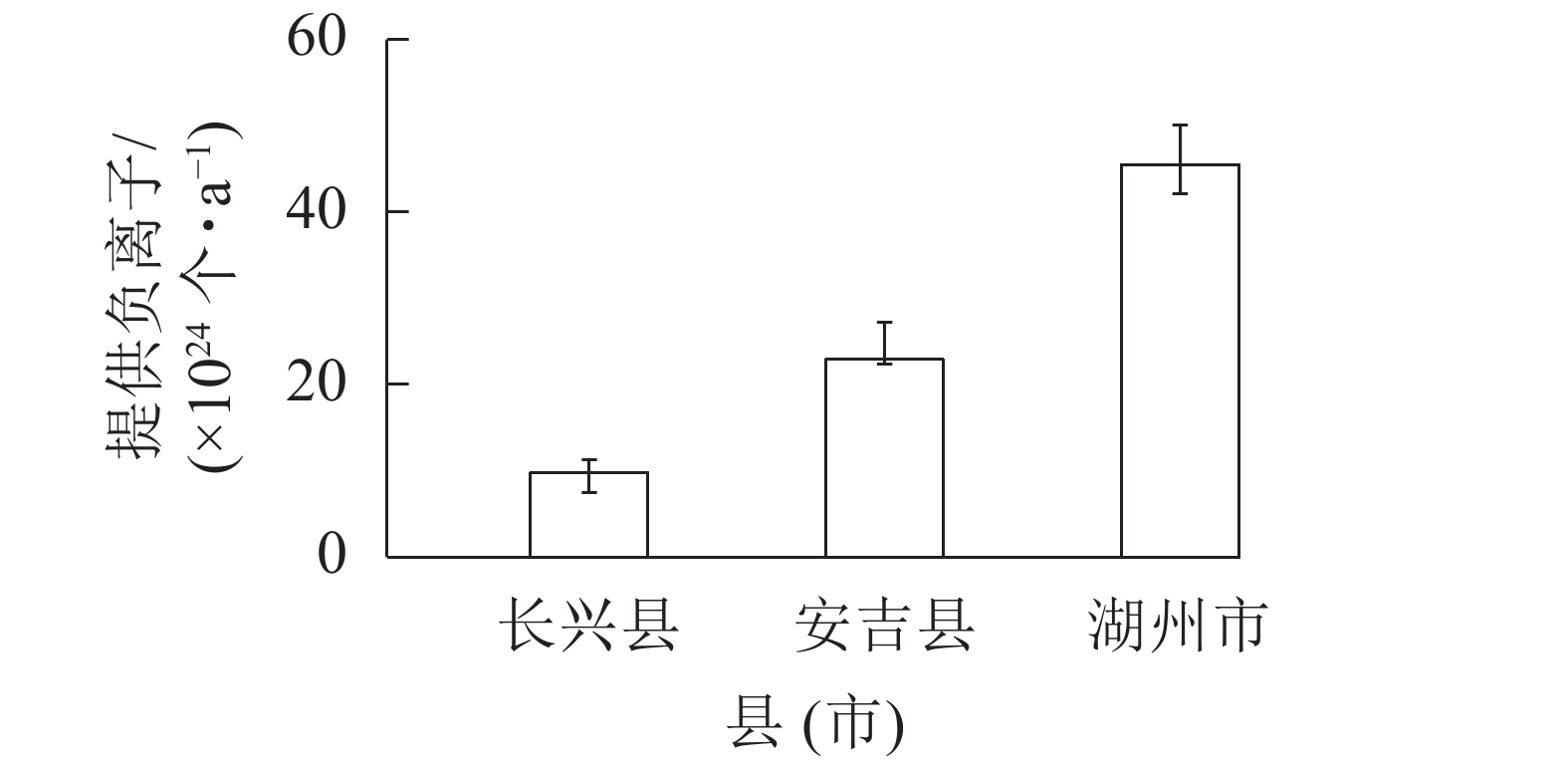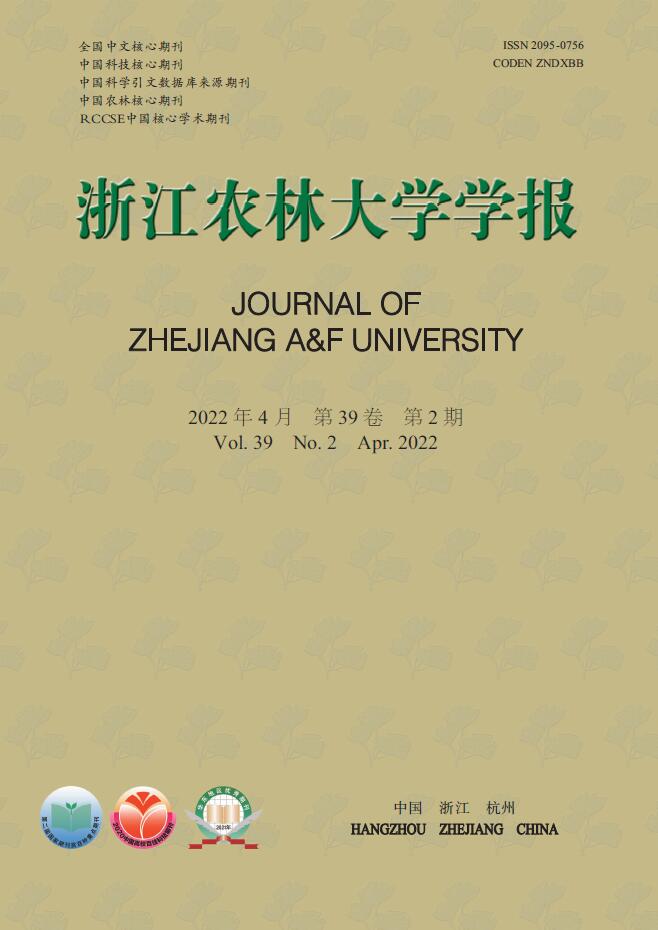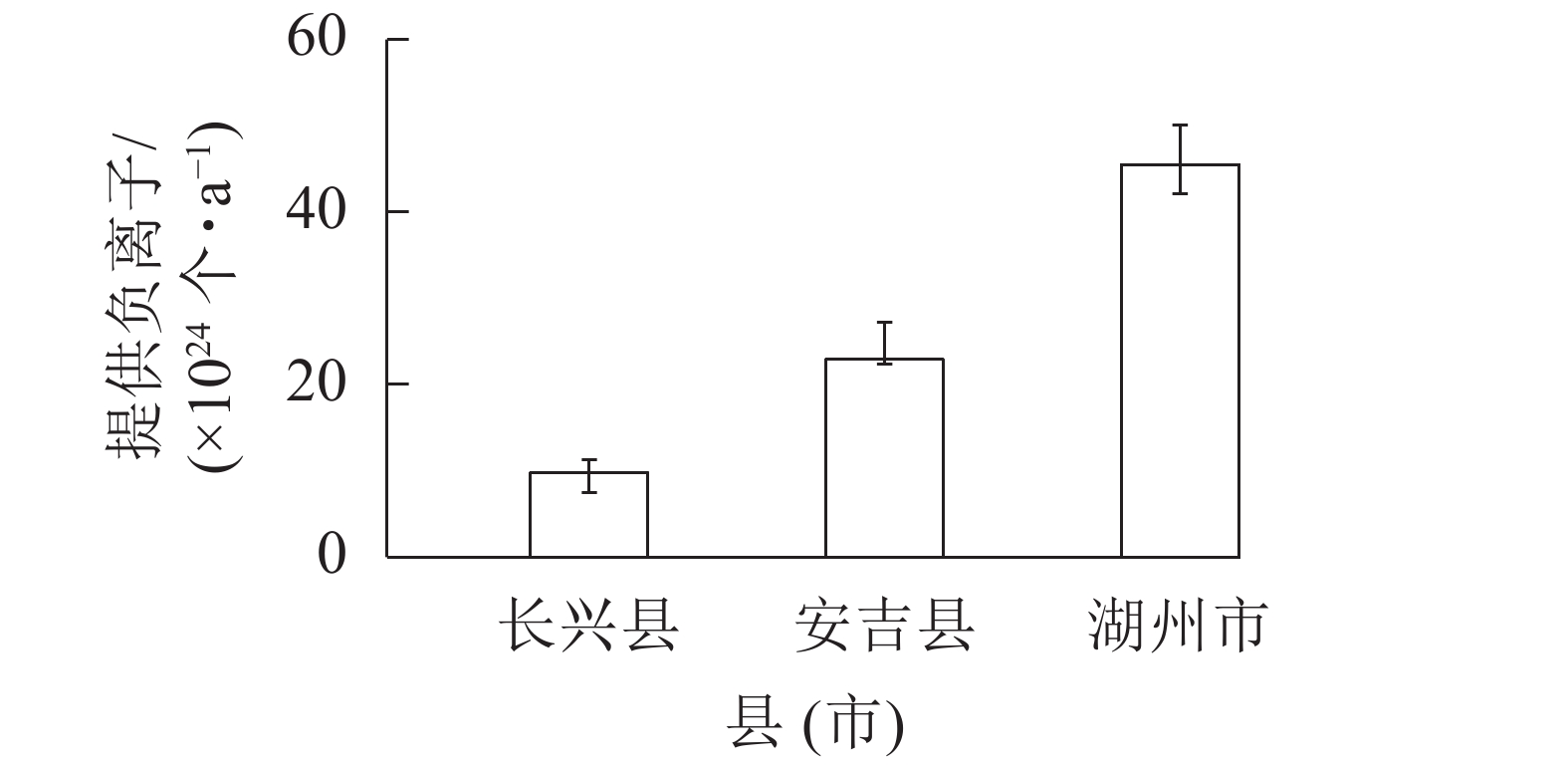-
森林是陆地生态系统中具最大生物量和生物生产力的生态系统,是地球生物圈过程的重要参与者[1]。森林生态系统为人类社会提供了丰富的物质产品和文化产品[2],更为维护生态系统平衡发挥了水源涵养、土壤保育等多种调节服务功能[3]。这些由森林生态系统与生态过程所形成及维持的人类赖以生存的自然环境条件与效用即为森林生态系统服务功能[4]。COSTANZA等[5]最早对全球16类生态系统服务价值进行了估算,其中将森林生态系统分为热带和温带进行价值估算。此后,国内外学者聚焦于森林生态系统服务功能概念内涵[6]和方法应用[7]进行了研究,国内获得了森林生态连清技术体系[8]、生态系统生产总值(GEP)核算[9]、国标GB/T 3858—2020《森林生态系统服务功能评估规范》[10]等研究成果。现阶段,国内许多学者基于此国标,采用森林资源规划设计调查(“二类”调查)数据,对省[11]、市[12]、县[13],以及自然保护地[14]、典型森林生态系统[15]等各层级的森林生态系统开展了服务功能核算。鉴于采用“二类”调查数据能够将核算结果落实到山头地块,从生态区位[16]、空间格局[17]等角度切入,细致探究森林生态系统服务功能机制也逐渐成为学界关注的焦点。
森林资源数据是整项核算工作的最基本数据。近些年,基于“二类”调查数据对各层级森林生态系统服务功能核算研究越来越多,但“二类”调查数据没有调查精度控制[18],累加后形成的上级行政区森林资源结果亦无精度控制[19]。如何对基于“二类”调查数据的森林生态系统服务功能核算结果进行精度控制,并没有在现有研究中得到重视。使用森林资源连续清查(“一类”清查)数据,通过系统抽样统计方法可使核算结果具有很高的精度保证和较好可信度[20]。鉴于物质量核算能够比较客观地反映森林生态系统的生态过程[15],本研究选取浙江省湖州市为研究地,使用“一类”清查样地数据和“二类”调查小班数据,将样地宏观核算和小班微观核算紧密结合,构建森林生态系统服务功能物质量市县联动核算体系,以期为解决上述问题提供参考。另外,也能够在把握市、县森林生态系统服务功能总体趋势的同时,为多层级核算结果的精度保证提供参考和借鉴。
-
湖州市位于浙江省最北端,辖吴兴区、南浔区、长兴县、德清县和安吉县,土地总面积5 824 km2。境内地形地貌以低山丘陵、湖积和冲积平原为主,地势大致呈现由西向东北倾斜的走势。全境为亚热带季风性气候,年均气温为12.2~17.3 ℃,多年平均降水量为761~1 780 mm。根据2018年森林资源监测结果(表1),湖州市林地面积为2 891.7 km2,其中森林面积为2 802.1 km2 (含一般灌木林面积)。森林蓄积量为759.1万 m3,森林覆盖率为48.1%。
县(区) 森林面
积/km2森林面积
占比/%森林蓄积量/
(×104 m3)森林蓄积量
占比/%吴兴区 329.4 11.7 127.4 16.8 南浔区 69.8 2.5 8.0 1.1 德清县 400.0 14.3 77.7 10.2 长兴县 678.9 24.2 212.7 28.0 安吉县 1 324.0 47.3 333.3 43.9 总计 2 802.1 100.0 759.1 100.0 Table 1. Forest areas, inventory and percentages of Huzhou City in 2018
-
森林生态系统服务功能包括供给服务、调节服务、文化服务和支持服务[21]。根据国标GB/T 38582—2020《森林生态系统服务功能评估规范》,本研究对湖州市森林生态系统的水源涵养、土壤保育、固碳、林木养分固持和提供负离子等5项服务功能物质量进行市县联动核算与精度控制研究,指标选取说明见表2。
服务类别 功能类别 指标类别 说明 供给服务 生物多样性 物种资源保育 主要通过野生动植物资源调查成果核算,故未纳入 林木产品供给 木材产品 此2项指标的产量一般是统计数据,与本研究目的不一致,故未纳入 非木材产品 调节服务 水源涵养 调节水量 此2项指标物质量核算方法与结果均一致,仅在评估价值量时,分别选取
不同单价。在实际应用中,水源涵养物质量也仅指调节水量。因此,本
研究选择调节水量一项指标,且后文中的水源涵养表述仅指代调节水量净化水质 固碳释氧 固碳 此2项指标核算方法差异仅体现在转换参数不同,而且,释氧量可通过固
碳量直接乘以氧气(O2)与碳(C)的相对原子质量比得到。因此,本研究
仅选择固碳一项指标释氧 净化大气环境 提供负离子 由于森林单位面积吸收气体污染物及滞纳TSP等的实测参数不足,本研究
仅选择提供负离子一项指标吸收气体污染物 滞纳TSP、PM10、PM2.5 森林防护 防风固沙 研究区不属于风力侵蚀区域。农田防护功能仅针对农田境界外100 m范围
内的森林。且2类调查数据未能界定森林是否为农田防护林,因此未选
取该2项指标农田防护 文化服务 森林康养 森林康养 森林康养价值一般是统计数据,或通过条件价值法等方法核算。与本研
究目的不一致,未选取该指标支持服务 保育土壤 固土 考虑到保肥量仅是固土量乘以土壤营养元素百分比含量(为常数)得到,固
土量核算精度决定了保肥量核算精度。因此,本研究仅选择固土指标。
且后文中的保育土壤表述仅指代固土保肥 林木养分固持 氮、磷、钾固持 该指标反映了林木吸收氮、磷、钾等营养元素并储存在体内的功能,因
此,本研究选择此3项指标,并以此3项指标物质量之和作为林木养分
固持物质量Table 2. Index system of forest ecosystem services function and explanation of index selection
-
“一类”清查数据源于湖州市961个样地的现场调查。“二类”调查数据源于2018年湖州市县级森林资源监测,该数据由2016年全面调查完成的森林资源数据年度更新形成。
数字高程模型(DEM)来源于地理空间数据云,采用ArcGIS 10.2重分类至分辨率10 m。年降水量和蒸发量数据来源于中国气象数据网,通过反距离权重法插值形成栅格数据,分辨率为10 m。地表径流系数参考文献[22]。土壤数据来源于浙江省土壤普查成果。植被净初级生产力采用2018年浙江省4 319个公益林固定样地监测成果。林分负离子量采用2018年浙江省62个空气负离子监测点测定成果。林木的氮、磷、钾含量参考文献[23]。
-
市县联动核算体系由1个市级总体和5个县级副总体组成。市级总体为湖州市,县级副总体以县(区)为单位进行划分。
-
①样地核算体系(YD)。该体系分为市级总体样地核算(YD_S)和县级副总体样地核算(YD_X)2个子体系,采用“一类”清查数据,按系统抽样核算方法[24],将单个样地的森林生态系统服务功能物质量推算到市、县级尺度并提供精度控制。2016—2018年,湖州市在477个省级样地(该477个样地是湖州市域范围内的浙江省级样地,以4 km×6 km间距布设)基础上,再按95%的可靠度,全市森林面积估计精度达到90%以上、活立木蓄积量估计精度达到85%以上的设计要求,以2 km×3 km间距加密布设484个市级样地,共计布设样地961个。其中,吴兴区134个、南浔区121个、德清县158个、长兴县236个、安吉县312个。单个样地面积为0.08 hm2,形状为正方形。②小班核算体系(XB)。该体系分为市级总体小班汇总(XB_S)和县级副总体小班核算(XB_X)2个子体系,采用“二类”调查数据,将各小班的森林生态系统服务功能物质量累加得到县级副总体核算结果,将各县级副总体核算结果累加得到市级总体汇总结果。
-
①同步核算机制。第一,市对县森林面积控制检验。森林面积对森林生态系统服务功能有着较高影响[25],按照张国江等[18]提出的方法进行市对县森林面积控制检验。市级森林面积核算结果估计精度92.99%,置信区间为250 772~288 524 hm2,县级副总体森林面积之和落在置信区间内,表明其森林面积有精度保证。第二,核算体系出数。针对YD_S和YD_X、XB_S和XB_X子体系,根据“2.3.2”分别核算森林生态系统服务功能物质量。
②相容机制。通过县对自身、市对县的小班核算体系(XB)结果是否落在样地核算体系(YD)置信区间内的双控制,来确认各级核算结果是否相容,降低核算误差。XB_X核算结果必须受YD_X核算置信区间控制[式(1)],满足该条件后,XB_S结果必须受YD_S的置信区间控制[式(2)],任意一项不满足,通过修正机制对XB_X核算结果进行修正。
式(1)中:Ubj和Gbj分别为基于“二类”调查、“一类”清查数据的县级副总体b的第j类森林生态系统服务功能物质量;Ab为县级副总体b的土地总面积;μa为显著性水平a=0.05时的值,即1.96;
$S_{\overline y_{bj}} $ 为基于“一类”清查数据的县级副总体b的第j类森林生态系统服务功能物质量平均数标准误;Gj为基于“一类”清查数据的市级总体的第j类森林生态系统服务功能物质量;A为市级总体的土地总面积;$S_{\overline y_{j} }$ 为基于“一类”清查数据的市级总体的第j类森林生态系统服务功能物质量平均数标准误。③修正机制。第一,核算结果单位面积法修正。出现相容机制中所述情况的,则基于YD_S,采用[式(3)]对XB_X核算结果进行修正。
式(3)中:Ubj(R)为修正后县级副总体b的第j类森林生态系统服务功能物质量;yaij为YD_S中,第a种森林类型(a=1为乔木林,a=2为竹林,a=3为灌木林)的第i个样地的第j类森林生态系统服务功能物质量;Sai为YD_S中,第a种森林类型的第i个样地面积;Sbaj(XB)为县级副总体b的第a种森林类型的第i个小班面积。
第二,产出核算结果。本研究所述的精度控制是指样地核算体系(YD)置信区间可以包含小班核算体系(XB)结果,小班核算结果即有精度保证。在此种情况下,产出基于小班核算体系(XB)的结果。因为在有精度保证的同时,小班核算结果可以落到山头地块,反之,则产出基于样地核算体系(YD)的结果。
-
由表3可见:县级副总体中,仅长兴县和安吉县的提供负离子物质量“二类”核算值未能落入置信区间;从估计精度看,安吉县和长兴县估计精度较高,南浔区估计精度最低。主要是961个样地基于市级总体森林资源空间变动系数和相对误差布设,县级副总体范围内的市级样地估计精度还受到县内森林破碎化程度带来的影响,南浔区地处杭嘉湖平原,森林空间分布零散,变异系数大。安吉县和长兴县以山地丘陵为主,森林面积占比较高,变异系数较小。

Figure 1. Comparion of CSLM and CLM volume of NAI between plots assessing results (a=0.05) and revised results
县级副总体 项目 水源涵养/
(×104 t·a−1)保育土壤/
(×104 t·a−1)固碳/
(×104 t·a−1)林木养分固持/
(×104 t·a−1)提供负离子/
(×1024个·a−1)吴兴区 估计中值 16 872.07 76.68 11.43 0.42 4.76 置信区间 13 852.14~19 892.00 63.34~90.03 7.78~15.08 0.29~0.55 3.30~6.23 估计精度/% 82.10 82.60 68.03 68.38 69.29 “二类”核算值 18 874.43 84.05 12.58 0.48 5.93 南浔区 估计中值 4 809.83 30.52 2.26 0.04 0.29 置信区间 3 466.21~6 153.45 22.01~39.04 1.33~3.18 0.02~0.06 0.14~0.45 估计精度/% 72.07 72.10 59.17 55.68 46.52 “二类”核算值 3 505.14 18.94 1.81 0.05 0.35 德清县 估计中值 20 895.11 100.76 16.59 0.56 6.93 置信区间 17 552.31~24 237.91 85.74~115.78 12.11~21.07 0.41~0.71 5.37~8.50 估计精度/% 84.00 85.10 73.01 73.08 77.44 “二类”核算值 23 458.00 100.25 17.42 0.54 6.42 长兴县 估计中值 39 992.91 195.04 28.07 1.09 9.40 置信区间 35 102.35~44 883.47 171.93~218.16 23.39~32.76 0.90~1.28 7.52~11.27 估计精度/% 87.77 88.15 83.30 82.77 80.04 “二类”核算值 39 843.56 172.78 27.98 1.15 6.85 安吉县 估计中值 76 780.87 357.00 58.43 2.06 24.79 置信区间 70 454.48~83 107.27 330.41~383.60 51.90~64.97 1.80~2.31 22.37~27.22 估计精度/% 91.76 92.55 88.81 87.71 90.23 “二类”核算值 79 087.77 345.53 52.62 1.82 19.49 Table 3. Accounting results of forest ecosystem services amount of CLSM
-
各森林生态系统服务功能物质量的估计精度都超过90%,除提供负离子,其他核算结果均落入市级样地核算置信区间(表4)。水源涵养的市级总体小班汇总结果大于估计中值,比较2类调查所得的不同优势树种面积和蒸散率发现,“一类”清查数据的优势树种平均蒸散率为54.01%,“二类”调查为53.41%,而林分蒸散率越高,其水源涵养能力越低。保育土壤、固碳、林木养分固持的市级总体小班汇总结果均小于估计中值,主要原因是保育土壤物质量采用ULSE模型,由于“一类”清查得到的全市森林平均郁闭度(为0.71)比“二类”调查(为0.68)高,故所用的植被覆盖因子(C)更小。森林年蓄积量变化一定程度反映了森林固碳和林木养分固持的功能,“一类”清查得到全市森林单位面积蓄积69.04 m3·hm−2、蓄积年增率6.02%,均高于“二类”调查(63.45 m3·hm−2,5.95%)。平均树高是提供负离子物质量核算时的重要参数。“一类”清查得到的全市平均树高为8.5 m,相较高1.2倍,使得市级总体小班汇总结果未能落在置信区间内。
服务功能 水源涵养/
(×104 t·a−1)保育土壤/
(×104 t·a−1)固碳/
(×104 t·a−1)林木养分固持/
(×104 t·a−1)提供负离子/
(×1024个·a−1)估计中值 159 031.95 759.24 116.61 4.16 46.08 置信区间 148 728.91~169 334.98 712.62~805.86 106.16~127.06 3.77~4.55 42.06~50.10 估计精度/% 93.52 93.86 91.04 90.59 91.28 市级总体小班汇总结果 164 768.90 721.55 112.41 4.04 39.04 Table 4. Accounting results of forest ecosystem services amount of CLM
-
根据市县联动核算机制和式(3),对长兴县和安吉县的提供负离子核算结果进行修正(表5)。修正后,2个县提供负离子均落入YD_X的置信区间。市级总体森提供负离子汇总结果为45.46×1024个·a−1,也落入YD_S的置信区间(图1)。
项目 提供负离子/(×1024个·a−1) 样地(小班)面积/hm2 合计 乔木林 竹林 灌木林 乔木林 竹林 灌木林 市级样地 0.006 087 0.001 873 0.000 353 0.000 261 14.96 15.60 9.04 长兴县修正结果 9.80 5.04 4.47 0.29 40 277.67 17 629.53 9 984.00 安吉县修正结果 22.96 5.59 16.75 0.63 44 634.53 66 082.60 21 686.20 说明:修正结果为(各森林类型小班面积×对应森林类型市级样地的合计提供负离子物质量)/对应森林类型市级样地合计面积 Table 5. Revision of assessing results of negative air ion supply of CLSM (Changxing County and Anji County)
-
本研究以湖州市为研究地,基于森林资源“一类”清查样地数据和“二类”调查小班数据,以样地和小班为纽带,构建了森林生态系统服务功能物质量市县联动核算体系。核算体系包括1个市级总体和5个县级副总体的核算布局;样地和小班2个核算体系;市县2级的同步核算机制,县对县、市对县核算结果双控制的相容机制,市对县核算结果修正的纠错机制3方面构成的联动核算机制。通过市县联动核算体系,为各级核算结果提供精度控制。从核算结果看,2018年,湖州市森林生态系统实现水源涵养量164 768.91万 t、保育土壤量721.54万 t、固碳量112.40万 t、林木养分固持量4.05万 t、提供负离子量45.46×1024个。从市级总体核算精度看,在显著性水平a=0.05下,森林生态系统服务功能物质量核算结果的估计精度均超过90%。
“一类”清查和“二类”调查属不同森林资源调查体系,故所得森林面积、林分测树因子不同,而森林生态系统服务功能量与森林面积、质量、气候环境有关[25],因此2类核算体系的核算结果也不一致。水源涵养、保育土壤、固碳和林木养分固持的小班汇总结果都能落入样地核算置信区间内,说明基于“二类”调查数据的核算结果是有精度保证的,其精度可直接采用估计精度数值。2类调查体系树高的调查差异使小班核算的提供负离子物质量不能落入样地核算置信区间,这主要是由于树高与空气负离子浓度差值有显著正相关[26]。不同县级副总体估计精度差异较大,地貌带来的森林破碎化程度是估计精度差异较大的客观原因,山地丘陵地区的土地利用类型以林地为主,变异系数较小,估计精度较高。而平原地区土地利用类型多样,森林资源的空间零散分布导致变异系数大,降低了估计精度。有研究性[19]表明:“一类”清查有精度保证,其抽样置信区间控制能够确保基于小班的森林资源结果可靠。本研究也证明了利用样地核算所得置信区间控制小班核算结果的方法可行性。本研究基于市级总体构建样地核算体系(YD),县级副总体的森林破碎化程度会对YD_X的估计精度带来影响。鉴于分层抽样[27]、不等概抽样[28]等能够提高森林资源监测结果精度,未来可探究上述抽样方案在森林生态系统服务功能核算时的精度控制效果。
综上所述,森林生态系统服务功能物质量市县联动核算体系能够为各级核算结果提供精度控制。小班核算体系(XB)结果落入样地核算体系(YD)置信区间,可使用样地核算体系(YD)估计精度,并采用前者核算结果确认区域森林生态系统服务功能物质量。反之,对小班核算结果进行修正,修正后仍不能落入置信区间的,应按样地核算结果进行确认。
City-county synchronized assessing and accuracy control of forest ecosystem services
doi: 10.11833/j.issn.2095-0756.20210328
- Received Date: 2021-04-26
- Accepted Date: 2021-11-17
- Rev Recd Date: 2021-10-18
- Available Online: 2022-03-25
- Publish Date: 2022-03-25
-
Key words:
- forest ecosystem services /
- forest resources /
- continuous forest inventory /
- forest management inventory /
- synchronized assessing
Abstract:
| Citation: | ZHU Chenghao, WANG Jianwu, XIE Binglou, et al. City-county synchronized assessing and accuracy control of forest ecosystem services[J]. Journal of Zhejiang A&F University, 2022, 39(2): 430-437. DOI: 10.11833/j.issn.2095-0756.20210328 |












 DownLoad:
DownLoad: